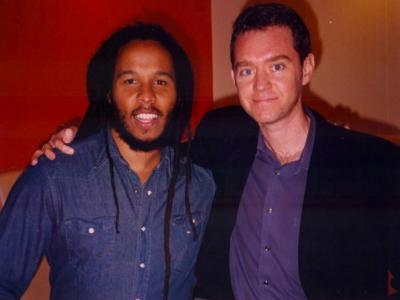Relay: Little Giants
Relay: Little Giants

“You’ve met everyone!” Durell Godfrey exclaimed last Thursday, just after the editorial meeting and moments before the bombshell tossed by TMZ, the celebrity-gossip website, landed in the office: Prince was dead.
Durell was referring to the actor Peter Dinklage, whom I have not actually met, and three of the four Beatles.
I must plead guilty to serial name-dropping, though. John and Paul and Ringo, Elton John, Mary J. Blige. It’s all in my first book, “Into the Twilight,” a collection of these “Relay”s that is available at Amazon, BookBaby, and elsewhere in cyberspace (call me for a print copy).
But it’s true, I have been fortunate to meet a lot of people I admire, and some other noteworthy people, too. Keith Richards, B.B. King, Donovan, Ziggy Marley, D.J. Fontana, Graham Nash, Ron Wood, Warren Haynes, Norah Jones, Percy Heath, Suzanne Vega, Ace Frehley, Don Was, Billy Joel, John Mayer, Bootsy Collins, Ray Manzarek, and Glenn Tilbrook come to mind. Telephone conversations with Chuck Berry, Brian Wilson, Bill Wyman, Quincy Jones, Mickey Hart, Billy Bob Thornton, Buddy Guy, Billy Gibbons, Robert Cray, Steve Earle, Lou Reed, Jorma Kaukonen, Jimmy Vaughan, Zakk Wylde.
I haven’t had a television for four years now, and I don’t miss it at all. Today’s “smart” TVs surpass my understanding, and anyway, all things audio and video have converged in my iMac. Programming like the cable news channels, “The Daily Show,” and, sometimes, baseball games are there, along with multiple lifetimes’ worth of musical video content on YouTube. What’s more, the tyranny of cable TV is fading as devices like Apple TV allow a la carte selection from a growing body of content.
Cooler still, HBO NOW allows anyone with an Internet connection to access its programming on a computer or mobile device. I signed up specifically to watch “Vinyl,” a series focusing on the music business, in all its sleazy glory, circa 1973.
As colleagues who were in the business at the time attest, those were the days. My years at Billboard and another trade magazine in New York City weren’t quite so wild as that depicted in “Vinyl,” but there are some parallels. I’ll neither confirm nor deny participation in backstage high jinks at a few Black Crowes concerts. Ditto for an impromptu encounter with Levon Helm and Hubert Sumlin at the Beacon Theatre. It’s all in my rock ’n’ roll memoir, available wherever unpublished books are sold. (Note to agents and publishers: Call me.)
During that semi-freewheeling time, I used to haul the laundry down from my sixth-floor walkup in Williamsburg to a Laundromat on Bedford Avenue. It was a mind-numbing chore, but one incident, a dozen or so years ago, stands out. Somewhere between pulling the clothes out of washing machines, throwing them into dryers, and inserting another thousand quarters, a silly contretemps played out before me when a young woman began accusing another patron of removing her still-damp clothes from the dryers and stuffing them into one of the rolling baskets you find at such places.
The accused, a dwarf, denied all charges, but the woman would have none of it. Of his guilt she was certain, and she yammered on about just how inconsiderate he was and terribly inconvenienced she was. Her life, in fact, was irrevocably ruined, if the incessant yap-yap was any indication.
I felt terrible for the poor man. His life was already hard enough, I was sure. To now suffer the indignity of being yelled at, in public, by this entitled, impudent youngster? It was wrong, but I said nothing.
A year or two later, I saw a preview for a film. I don’t remember its title or subject, but to my amazement, there he was, the dwarf from the Laundromat. He probably wasn’t dragging his laundry down Bedford Avenue anymore. His accuser? Toiling in obscurity to this day, I’d wager.
Yes, I have HBO NOW, now, but have not seen even one of the 51 episodes of “Game of Thrones,” starring Mr. Dinklage. I’m afraid to start for fear I won’t be able to stop, and thus will not accomplish anything ever again.
I never did meet Prince, nor see him perform. But he did sit directly in front me at a Sheryl Crow concert at the Beacon in, I think, 1999. (Yes, I have met Sheryl Crow a couple of times, once in the defunct Hit Factory studios, where she recorded a duet with Tony Bennett [yes, I have met Tony Bennett] but was too shy to say more than hello.)
Like Mr. Dinklage — well, not really like him — Prince was slight in stature, but the hoop earrings he wore were enormous and offset his otherwise understated attire. As Ms. Crow concluded the last song of her set, but before the encore, Prince and his companion(s) — one or two women, if memory serves — discreetly left the building.
Maybe I should have said hello.
Christopher Walsh is a reporter at The Star.
